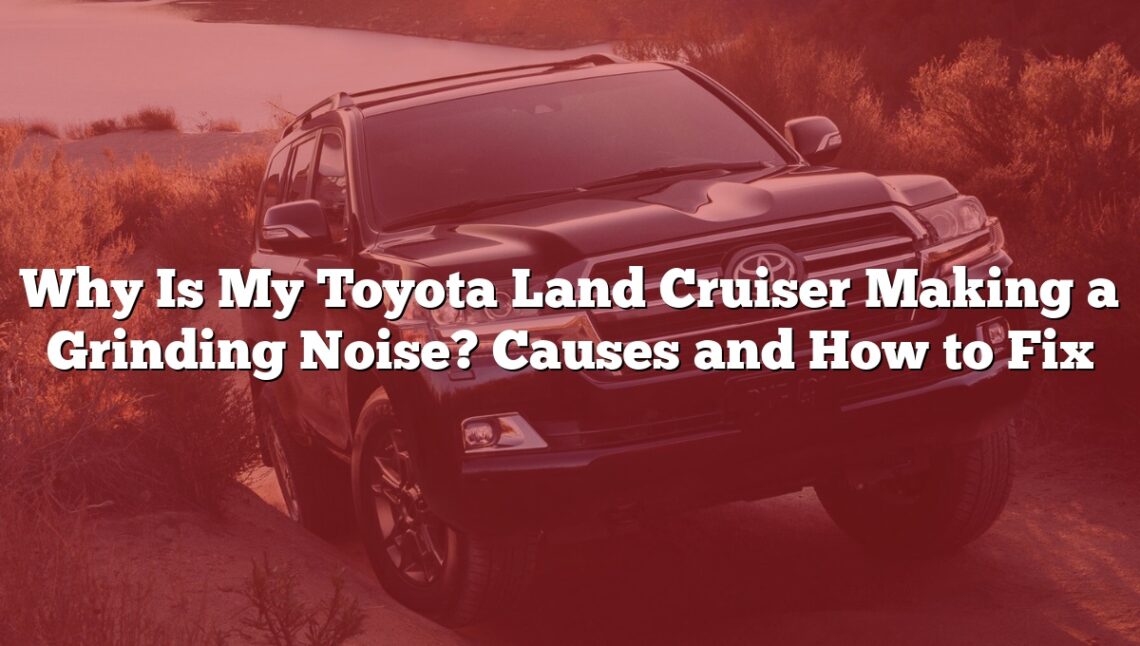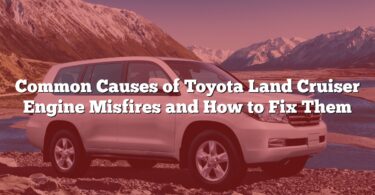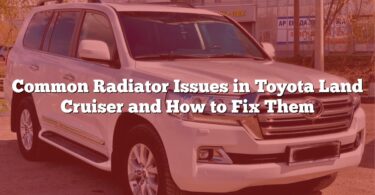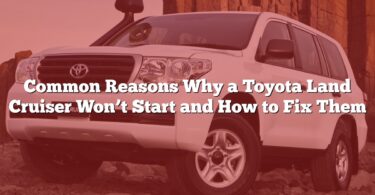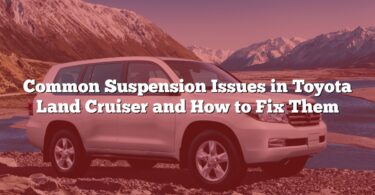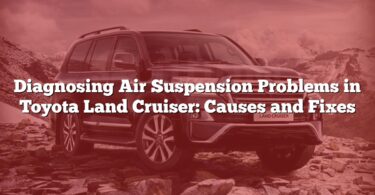Hearing a grinding noise from your Toyota Land Cruiser can be unsettling, especially if you’re unsure of the cause. Whether it’s coming from your brakes, drivetrain, or suspension, this guide will help you identify the potential problems and offer clear solutions to get your vehicle back in top shape. Understanding these issues early can save you time, money, and ensure a safer driving experience.
Problems and Solutions for Toyota Land Cruiser Grinding Noise
| N° | Problem/Cause | Solution |
|---|---|---|
| 1 | Worn brake pads | Replace brake pads with new ones. |
| 2 | Warped brake rotors | Resurface or replace the rotors. |
| 3 | Damaged wheel bearings | Inspect and replace the damaged bearings. |
| 4 | Failing CV joints | Replace the CV joint or axle shaft. |
| 5 | Driveline issues | Diagnose and repair or replace driveline components. |
| 6 | Transfer case damage | Inspect and rebuild or replace the transfer case. |
| 7 | Worn or damaged suspension components | Replace the damaged or worn suspension parts. |
| 8 | Faulty differential gears | Repair or replace the differential gears. |
| 9 | Low or contaminated differential fluid | Drain, clean, and refill with fresh differential fluid. |
| 10 | Transmission problems | Diagnose and repair the transmission system. |
| 11 | Worn clutch components (manual transmission) | Replace the clutch or its related parts. |
| 12 | Debris stuck in the brake system | Remove debris and inspect for damage. |
| 13 | Misaligned brake calipers | Re-align or replace the calipers. |
| 14 | Damaged or worn-out bushings | Replace the worn or damaged bushings. |
| 15 | Loose or damaged undercarriage components | Tighten or replace the affected components. |
| 16 | Exhaust system contact with chassis | Adjust or secure the exhaust system. |
| 17 | Faulty serpentine belt or tensioner | Replace the belt or tensioner. |
| 18 | Damaged or loose skid plates | Tighten or replace skid plates. |
| 19 | Low power steering fluid | Refill power steering fluid and check for leaks. |
| 20 | Internal engine damage | Diagnose and repair internal engine components. |
| 21 | Worn out U-joints | Replace the U-joints. |
| 22 | Axle issues | Inspect and repair or replace the axle. |
| 23 | Contaminated or degraded gearbox fluid | Flush and replace gearbox fluid. |
| 24 | Tire rubbing against the body | Adjust or replace tires and ensure proper alignment. |
| 25 | Broken or worn shock absorbers | Replace the shock absorbers. |
| 26 | Loose wheel lug nuts | Tighten all wheel lug nuts to the correct torque. |
| 27 | Foreign object lodged in drivetrain components | Remove the object and inspect for damage. |
| 28 | Damaged fan or cooling system parts | Repair or replace the damaged components. |
| 29 | Uneven brake wear | Inspect and replace unevenly worn brake parts. |
| 30 | Improperly installed or defective aftermarket parts | Correct installation or replace defective parts. |
| 31 | Debris and rocks bouncing off brake calipers | Remove debris and clean the area. |
| 32 | Brake disc and caliper wear | Replace worn discs or calipers. |
| 33 | Anti-lock braking system malfunction | Diagnose and repair ABS system. |
| 34 | Worn-out bearings | Replace the bearings. |
| 35 | Suspension issues during turning | Repair or replace the suspension components. |
| 36 | Severe CV joint damage | Replace the CV joint. |
Detailed Guide : Problems and Solutions for Toyota Land Cruiser Grinding Noise
1. Worn Brake Pads
- Reason: Brake pads wear down over time due to friction. Once they are excessively worn, the metal backing plate makes contact with the brake rotor, causing a grinding noise.
- Solution: Replace the brake pads.
- Step 1: Remove the wheel to access the brake assembly.
- Step 2: Detach the caliper and remove the old brake pads.
- Step 3: Install new brake pads and reassemble the components.
- Step 4: Test the brakes for proper function.
2. Warped Brake Rotors
- Reason: Excessive heat or uneven wear can warp brake rotors, leading to grinding when braking.
- Solution: Resurface or replace the rotors.
- If rotors are salvageable, a mechanic can machine them to create a smooth surface. If not, replacement is necessary.
3. Damaged Wheel Bearings
- Reason: Worn or damaged wheel bearings cause grinding due to metal-on-metal contact.
- Solution: Inspect and replace the wheel bearings.
- Step 1: Lift the vehicle and spin the wheels to identify the faulty bearing.
- Step 2: Remove the hub assembly to access the bearing.
- Step 3: Install a new bearing and reassemble the hub.
4. Failing CV Joints
- Reason: Worn CV joints can produce a grinding noise, especially during turns.
- Solution: Replace the CV joint or axle shaft.
- Ensure the new CV joint is properly greased and secured.
5. Driveline Issues
- Reason: Problems in the driveline, such as worn universal joints or misaligned components, cause grinding noises.
- Solution: Diagnose the driveline system and replace any faulty parts. Realign components if needed.
6. Transfer Case Damage
- Reason: Internal damage to the transfer case can result in grinding sounds, particularly in four-wheel drive mode.
- Solution: Inspect the transfer case. Rebuild or replace it if necessary.
7. Worn or Damaged Suspension Components
- Reason: Suspension parts such as control arms or bushings wear out over time, causing grinding noises.
- Solution: Replace the worn or damaged suspension components. Ensure all bolts and connections are tightened properly.
8. Faulty Differential Gears
- Reason: Grinding in the differential occurs when gears are worn or damaged.
- Solution: Repair or replace the differential gears. Use the manufacturer-recommended gear oil for lubrication.
9. Low or Contaminated Differential Fluid
- Reason: Insufficient or dirty differential fluid leads to poor lubrication and grinding.
- Solution: Drain the differential fluid, clean the system, and refill with fresh fluid.
10. Transmission Problems
- Reason: Grinding noises may indicate issues with transmission gears or synchronizers.
- Solution: Have the transmission inspected by a professional. Repair or replace damaged components.
11. Worn Clutch Components (Manual Transmission)
- Reason: A worn clutch or pressure plate causes grinding during gear shifts.
- Solution: Replace the clutch assembly, including the pressure plate and release bearing.
12. Debris Stuck in the Brake System
- Reason: Foreign objects like small rocks can lodge in the brake system, creating grinding sounds.
- Solution: Remove debris and inspect the brake system for damage. Clean thoroughly.
13. Misaligned Brake Calipers
- Reason: Misalignment leads to uneven brake pad wear and grinding.
- Solution: Re-align the calipers or replace them if necessary.
14. Damaged or Worn-Out Bushings
- Reason: Bushings that cushion suspension components can degrade, causing grinding noises.
- Solution: Replace the damaged bushings with new ones.
15. Loose or Damaged Undercarriage Components
- Reason: Loose undercarriage parts can vibrate and create grinding sounds.
- Solution: Inspect and tighten or replace any loose components.
16. Exhaust System Contact with Chassis
- Reason: A loose exhaust system can come into contact with the chassis, creating a grinding noise.
- Solution: Adjust or secure the exhaust system.
17. Faulty Serpentine Belt or Tensioner
- Reason: A worn serpentine belt or faulty tensioner can cause grinding sounds.
- Solution: Replace the belt and check the tensioner for proper function.
18. Damaged or Loose Skid Plates
- Reason: Loose skid plates may rub against other parts, producing grinding noises.
- Solution: Tighten or replace the skid plates.
19. Low Power Steering Fluid
- Reason: Insufficient power steering fluid causes grinding when turning.
- Solution: Refill the power steering fluid and check for leaks.
20. Internal Engine Damage
- Reason: Severe internal engine damage, such as worn pistons, can cause grinding.
- Solution: Consult a professional mechanic to diagnose and repair internal engine issues.
21. Worn-Out U-Joints
- Reason: Worn U-joints in the drivetrain cause grinding, especially during acceleration.
- Solution: Replace the U-joints with high-quality parts.
22. Axle Issues
- Reason: Damaged or bent axles can cause grinding noises, especially during acceleration or turning.
- Solution: Inspect the axles for damage.
- Step 1: Lift the vehicle and check the axles for visible bends or cracks.
- Step 2: Replace the damaged axle with a new or refurbished one.
23. Contaminated or Degraded Gearbox Fluid
- Reason: Old or contaminated gearbox fluid fails to provide proper lubrication, leading to grinding noises.
- Solution: Flush the gearbox and replace the fluid.
- Use the type of gearbox oil specified in the vehicle’s manual to ensure optimal performance.
24. Tire Rubbing Against the Body
- Reason: Improperly sized or misaligned tires can rub against the wheel well or body.
- Solution: Adjust or replace the tires.
- Step 1: Inspect tire size and alignment.
- Step 2: Replace the tires with ones that meet manufacturer specifications.
- Step 3: Align the wheels properly to avoid further issues.
25. Broken or Worn Shock Absorbers
- Reason: Worn-out shock absorbers can fail to dampen vibrations, causing grinding or clunking sounds.
- Solution: Replace the shock absorbers.
- Ensure the new shocks are compatible with your vehicle’s suspension system.
26. Loose Wheel Lug Nuts
- Reason: Loose lug nuts can cause grinding as the wheel wobbles.
- Solution: Tighten all lug nuts to the manufacturer-specified torque.
- Regularly check lug nuts to ensure they remain secure.
27. Foreign Object Lodged in Drivetrain Components
- Reason: Debris caught in the drivetrain can cause grinding noises.
- Solution: Remove the object and inspect for potential damage.
- Clean the area thoroughly to prevent recurrence.
28. Damaged Fan or Cooling System Parts
- Reason: A damaged fan blade or cooling component can grind against surrounding parts.
- Solution: Inspect and repair or replace damaged components.
- Check for loose connections or misaligned parts in the cooling system.
29. Uneven Brake Wear
- Reason: Uneven wear on brake pads or rotors leads to grinding noises during braking.
- Solution: Inspect and replace unevenly worn parts.
- Ensure proper caliper alignment and brake system maintenance.
30. Improperly Installed or Defective Aftermarket Parts
- Reason: Incorrectly installed or low-quality aftermarket parts may cause grinding.
- Solution: Reinstall parts correctly or replace them with high-quality components.
- Always follow manufacturer guidelines during installation.
31. Debris and Rocks Bouncing Off Brake Calipers
- Reason: Small debris can strike the brake calipers, causing intermittent grinding noises.
- Solution: Remove the debris and clean the area.
- Install a protective shield if debris issues persist.
32. Brake Disc and Caliper Wear
- Reason: Worn discs or calipers create grinding sounds during braking.
- Solution: Replace the worn discs and calipers.
- Ensure new components are compatible with your vehicle model.
33. Anti-Lock Braking System (ABS) Malfunction
- Reason: Malfunctions in the ABS can cause grinding, especially during hard stops.
- Solution: Diagnose the ABS system using a scanner.
- Repair or replace faulty sensors, modules, or hydraulic components.
34. Worn-Out Bearings
- Reason: Bearings degrade over time, causing grinding noises during driving.
- Solution: Replace the worn bearings.
- Lubricate new bearings thoroughly during installation for extended lifespan.
35. Suspension Issues During Turning
- Reason: Grinding noises during turns can be caused by worn suspension components like control arms or sway bars.
- Solution: Inspect and replace faulty suspension parts.
- Tighten all bolts and ensure proper alignment during installation.
36. Severe CV Joint Damage
- Reason: A severely damaged CV joint causes grinding noises, particularly when turning or accelerating.
- Solution: Replace the CV joint or the entire axle shaft.
- Step 1: Remove the damaged joint.
- Step 2: Install the new CV joint and ensure it is properly lubricated.
- Step 3: Test the vehicle to confirm the repair is effective.
Preventing Future Issues
To avoid recurring grinding noise problems in your Toyota Land Cruiser, follow these preventive measures:
- Perform Regular Maintenance
- Schedule periodic inspections of the brake system, drivetrain, suspension, and other critical components.
- Replace worn parts like brake pads, bearings, and belts as needed.
- Check Fluid Levels Frequently
- Ensure that all essential fluids, including brake fluid, differential fluid, and gearbox oil, are at the correct levels.
- Replace fluids according to the manufacturer’s recommended schedule to maintain optimal performance.
- Inspect Tires and Alignment
- Check for proper tire pressure and tread wear regularly.
- Ensure wheel alignment is correct to avoid unnecessary stress on the suspension and drivetrain.
- Avoid Overloading
- Keep your vehicle within its weight limits. Overloading can strain components like the suspension, brakes, and drivetrain.
- Clean Your Vehicle Regularly
- Wash your car, including the undercarriage, to remove debris that can get lodged in moving parts.
- Clean brake calipers and rotors if you frequently drive in dusty or muddy conditions.
- Drive Responsibly
- Avoid sudden, harsh braking and aggressive acceleration, as these can prematurely wear out components.
- Use appropriate gear settings, especially in off-road or heavy-load conditions, to reduce strain on the transfer case and drivetrain.
- Use High-Quality Parts and Fluids
- Choose OEM or high-quality aftermarket parts to ensure reliability and compatibility.
- Always use the recommended fluids for your vehicle.
- Monitor Warning Signs
- Pay attention to unusual noises or vibrations and address them promptly before they escalate into major issues.
- Use diagnostic tools if necessary to identify problems early.
- Follow Manufacturer Guidelines
- Refer to your Toyota Land Cruiser’s owner’s manual for maintenance schedules and service recommendations.
- Stick to the prescribed intervals for part replacements and inspections.
By following these steps, you can minimize the risk of future grinding noises and maintain the reliability and performance of your Toyota Land Cruiser. Regular care and attention to detail will keep your vehicle running smoothly for years to come.

